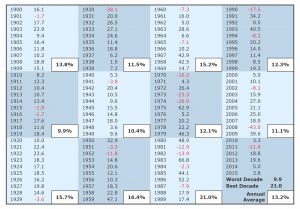Everyone has an opinion about what caused this latest bout of volatility in markets, coming after a long period of relative calm. But the key point for long-term investors is that markets are volatile by nature. Stocks go up and down as information and expectations change. Sometimes, this happens very gradually. Other times it happens more suddenly.
Increasing market volatility is essentially an expression of uncertainty. Markets move on new information which is incorporated into prices immediately. Those prices reflect the aggregate views of millions of participants, so unless you have information that no-one else is privy to, you are unlikely to get an edge by trying to time your entry and exit points.
What matters for individual investors is whether they are on track to meet their own long-term goals detailed in the plan designed for them. Unless you need the money next week, what happens on any particular day is neither here nor there. It is the long-term returns that count.
For those who may be feeling anxious, here are seven simple lessons to help you live with volatility:
1. Don’t make presumptions.
Remember that markets are unpredictable and do not always react the way the experts predict they will. For instance, you’ll see economists on the TV every night talking about what might happen when Europe or Japan eventually raise interest rates. But even if you could pick the turn, you still don’t know how markets will react. It’s pointless to speculate.
2. Someone is buying.
Quitting the equity market when prices are falling is like running away from a sale. When prices fall to reflect higher risk, that’s another way of saying expected returns are higher. And while the media headlines proclaim that “investors are dumping stocks,” remember someone is buying them. Those people are often the long-term investors.
3. Market timing is hard.
Recoveries can come just as quickly and just as violently as the prior correction. In 2008, the Australian share market fell by nearly 40%. Some investors capitulated, only to see the market bounce by more than 37% in 2009 and rise in seven of the eight subsequent years. The lesson is that attempts at market timing risk turning paper losses into real ones and paying for the risk without waiting for recovery.
4. Never forget the power of diversification.
Other assets like highly-rated government bonds can flourish when equity markets turn rocky. This limits the damage to balanced fund investors. So diversification spreads risk and can lessen the bumps in the road.
5. Markets and economies are different things.
The world economy is forever changing, and new forces are replacing old ones. This applies both between and within economies. For instance, falling oil prices can be bad for the energy sector but good for consumers. New economic forces are emerging as global measures of poverty, education, and health improve.
6. Nothing lasts forever.
Just as smart investors temper their enthusiasm in booms, they keep a reserve of optimism during busts. And just as loading up on risk when prices are high can leave you exposed to a correction, dumping risk altogether when prices are low means you can miss the turn when it comes. As always in life, moderation is a good policy.
Below is the equity returns from the Australian Share Market each decade over 115 years with all dividends reinvested. This includes periods of uncertainty such as 2 World Wars and the GFC.
115 Year Australian Share Market History over the Decades (Total Return)

7. Discipline is rewarded.
Market volatility can be worrisome, no doubt. The feelings generated are completely understandable. But through discipline, diversification, keeping focused on progress to your goals and accepting how markets work, the ride can be more bearable. At some point, value re-emerges, risk appetites re-awaken, and relief replaces anxiety for those who acknowledged their emotions without acting on them.
Stephen Lowry CFP, DFP, FAIM, is a representative of Alman Partners Pty Ltd, Australian Financial Services Licence No: 222107.
Note: This material is provided for information only. No account has been taken of the objectives, financial situation or needs of any particular person or entity. Accordingly, to the extent that this material may constitute general financial product advice, investors should, before acting on the advice, consider the appropriateness of the advice, having regard to the investor’s objectives, financial situation and needs. This is not an offer or recommendation to buy or sell securities or other financial products, nor a solicitation for deposits or other business, whether directly or indirectly.